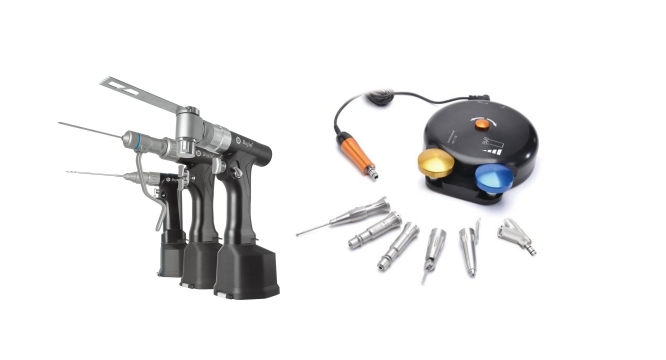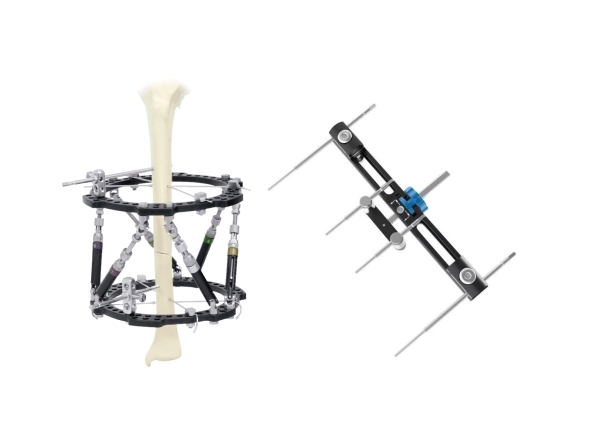Core Purpose: Orthopedic tools are specialized instruments used by orthopedic surgeons and healthcare professionals to diagnose, treat, manage, and rehabilitate conditions affecting the musculoskeletal system (bones, joints, muscles, ligaments, tendons, nerves).
Main Categories & Key Tools:
1. Diagnostic & Assessment Tools:
Imaging: X-ray machines, CT scanners, MRI machines, Ultrasound.
Arthroscopes: Miniature cameras inserted into joints (knee, shoulder) for visualization and minimally invasive surgery.
Goniometers: Measure joint range of motion.
Dynamometers: Measure muscle strength.
Tuning Forks: Test vibration sense (e.g., for nerve issues).
2. Surgical Instruments:
Basic Dissection: Scalpels, scissors, forceps, clamps, retractors (hold tissue/bone apart).
Bone Cutting & Shaping:
Osteotomes: Chisel-like for precise bone cuts.
Bone Saws: Electric/pneumatic oscillating or reciprocating saws for larger cuts (amputation, osteotomy).
Rongeurs: Strong “bite” tools to nibble away bone.
Curettes: Scoop-shaped to scrape bone or soft tissue.
Rasps/Files: Smooth rough bone edges.
Reamers: Enlarge or shape the marrow canal (e.g., for nail insertion).
Drilling & Fixation Insertion:
Drills & Drivers: Power tools for creating holes for screws, wires, pins.
Screwdrivers/T-handles: Manual insertion of screws.
Depth Gauges: Measure hole depth for correct screw length.
Wire Cutters/Twisters: For Kirschner wires (K-wires).
Joint Replacement Specific: Impactors, trials, specialized reamers, cement guns, alignment jigs.



3. Fixation Devices (Implants):
Internal Fixation: Placed inside the body to hold bone fragments.
Plates & Screws: For fractures, osteotomies, fusions.
Intramedullary Nails/Rods: Inserted down the marrow canal of long bones.
Pins & Wires (K-wires): Temporary or permanent stabilization.
Screws (Cannulated, Locking, Cortical, Cancellous): Various types for different bone qualities and functions.
External Fixation: Frame outside the body connected to bones via pins/wires.
Unilateral Frames, Circular Frames (Ilizarov), Hybrid Frames: For complex fractures, limb lengthening, severe trauma.



4. Casting, Splinting & Bracing Tools:
Casting Materials: Plaster, fiberglass rolls.
Splinting Materials: Prefabricated or moldable materials (plaster, fiberglass, foam, thermoplastics).
Cast Cutters & Spreaders: For safe removal.
Braces/Orthoses: Custom or off-the-shelf supports (knee, back, ankle, wrist, neck collars).
5. Rehabilitation & Mobility Aids:
Traction Equipment: Weights, pulleys, frames to apply pulling force (skin/skeletal traction).
Continuous Passive Motion (CPM) Machines: Move joints passively after surgery.
Walkers, Crutches, Canes: Assist with mobility during healing.
Therapeutic Modalities: TENS units, ultrasound machines (therapeutic), ice/heat packs.
6. Adjuncts & Biologics:
Bone Grafts & Substitutes: Autograft (patient’s own bone), allograft (donor bone), synthetic materials to fill defects or promote fusion.
Biologic Agents: PRP (Platelet-Rich Plasma), Stem Cells, BMP (Bone Morphogenetic Protein) – used to enhance healing.
Key Characteristics:
Durability: Made from strong, biocompatible materials (stainless steel, titanium alloys, cobalt-chrome).
Precision: Engineered for accuracy in cutting, shaping, drilling, and fixation.
Sterilizability: Must withstand repeated sterilization processes (autoclaving, chemical).
Specialization: Many tools are highly specific to particular joints (knee, hip, spine) or procedures (arthroscopy, fracture fixation, joint replacement).
In essence: Orthopedic tools encompass a vast array of instruments, from simple manual devices to complex power tools and sophisticated implants, all designed to restore the structure and function of the musculoskeletal system through diagnosis, surgery, fixation, immobilization, and rehabilitation.
